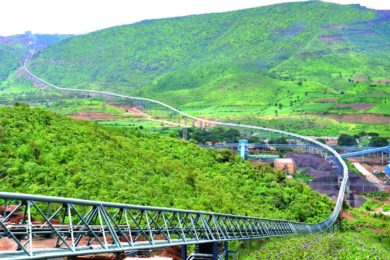China has unveiled an economic stimulus program which it says totals $586 billion. It is aiming to bolster domestic demand and help avert a global recession. According to Andrew Batson for the Wall Street Journal, “though the two-year package appeared to include some previously announced measures, its size was clearly designed to revive the fading confidence of Chinese businesses and consumers, and impress foreign governments. Asian shares rallied sharply early Monday on the Chinese announcement, with benchmark stock indexes in Tokyo, Hong Kong and Shanghai all jumping close to or above 5% in the early hours of trading.
“The announced sum of four trillion yuan represents about 16% of China’s economic output last year, and is roughly equal to the total of all central and local government spending in 2006. New spending of even half that amount would be substantial next to China’s six trillion yuan annual budget for this year.”
The interest for the mining industry is that the plan includes spending in housing and infrastructure. In particular, there is hope for a turn round in the steel sector.
Macquarie Research had just analysed steel industry inventories in China and noted that “despite recent production cuts, steel mill inventories remain under pressure as end-user demand has collapsed. While the mills are lowering prices to clear inventories, the buyers’ strike continues as traders await further price falls. Even more severe production cuts may be expected in the short term as mills struggle to clear inventories. This de-stocking is particularly severe as mills will try to work down stocks, not just to previous levels, but to even lower levels in the face of uncertain demand.
“Over the past week, the hot rolled coil price dipped to $419/t ex-vat, down by 1.5% from last week and cold rolled coil reported at $535/t ex-vat, down by 2.3% from last week.”
However, Macquarie also reported that “index iron ore spot prices rallied last week for the first time in many months. The two main index providers, Platts and Metal Bulletin, both reported a small recovery. Platts’ 62% Fe price rose to $60.00-60.50/t cfr, while the Metal Bulletin quote hit $61.55/t, both up 5% on the week. There appears to have been a rise in the volume of orders for the first time in a while, perhaps signalling an easing of the credit squeeze, which has hit demand in China.
Reported stocks of iron ore remain high, but current shipping schedules suggest a major collapse in Chinese iron ore imports in November and December; Vessel line-ups suggest a 20-25% reduction in Australian and Brazilian iron ore exports in November and December from levels of a few months ago; and Indian exports are down by 80% year-on-year.
Macquarie also reported that along with the major fall in global and Chinese aluminium prices, it was hearing “of a steep decline in aluminium raw material input cost including price drops in alumina, carbon anodes and thermal coal. As a result, we note some temporary relief on smelters’ cost margins.”
Rio Tinto today revised its estimate of iron ore shipments from the Pilbara region of Western Australia to between 170 and 175 Mt (100% basis) in 2008. As a result of the reduced demand from its customers and reduced shipments, the annualised run rate of iron ore production from its Pilbara mines will be reduced by approximately 10%.
Tom Albanese, Chief executive, Rio Tinto, said, “Operations continue to perform well but demand has continued to decelerate. This reduction is a prudent move to align production with revised customer delivery requirements in the light of the fourth quarter drop in Chinese demand. We believe this will be a short, sharp slowdown in China, with demand rebounding over the course of 2009, as the fundamentals of Chinese economic growth remain sound.”








